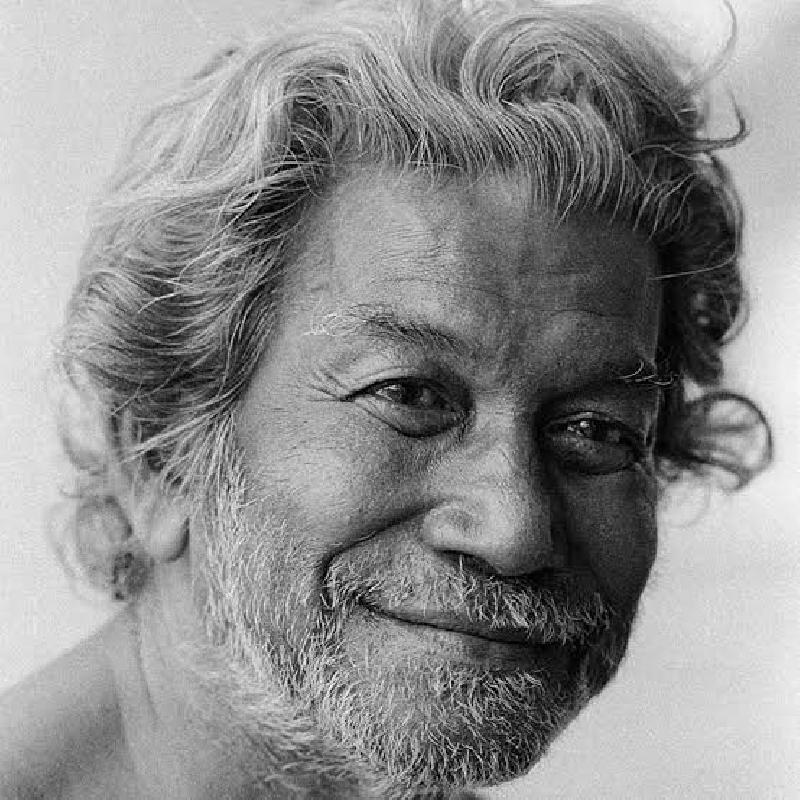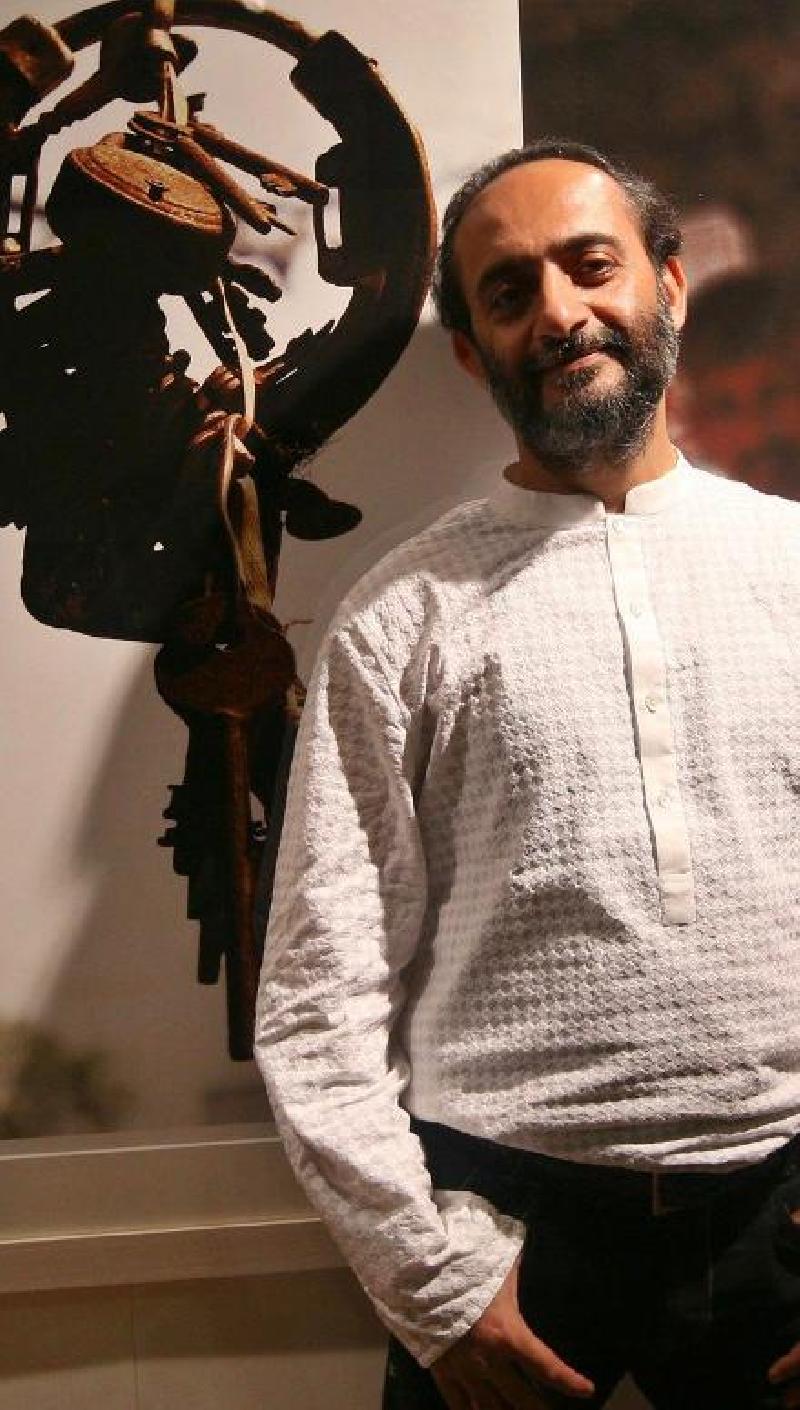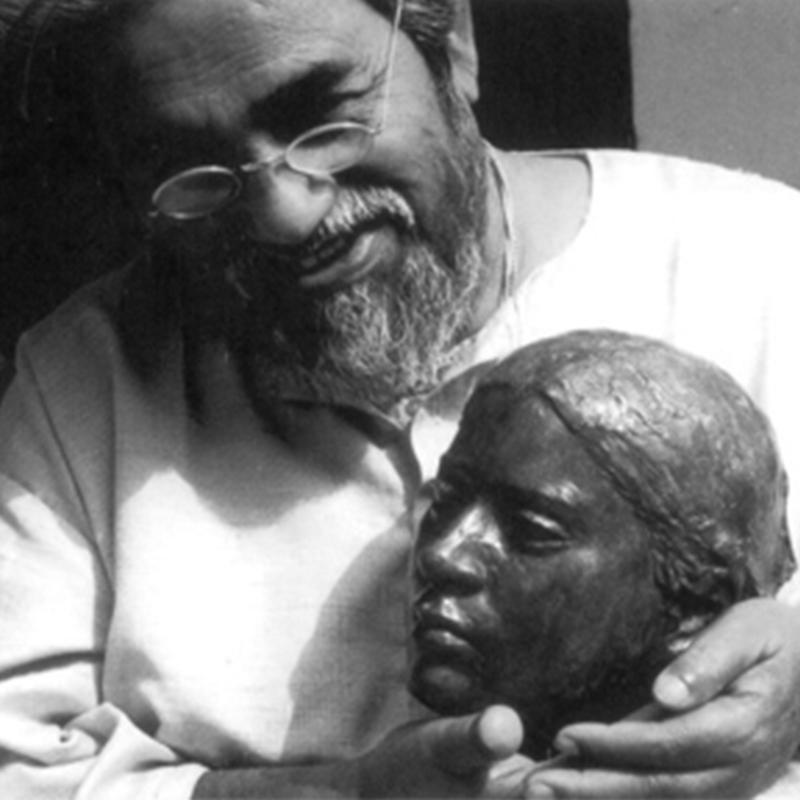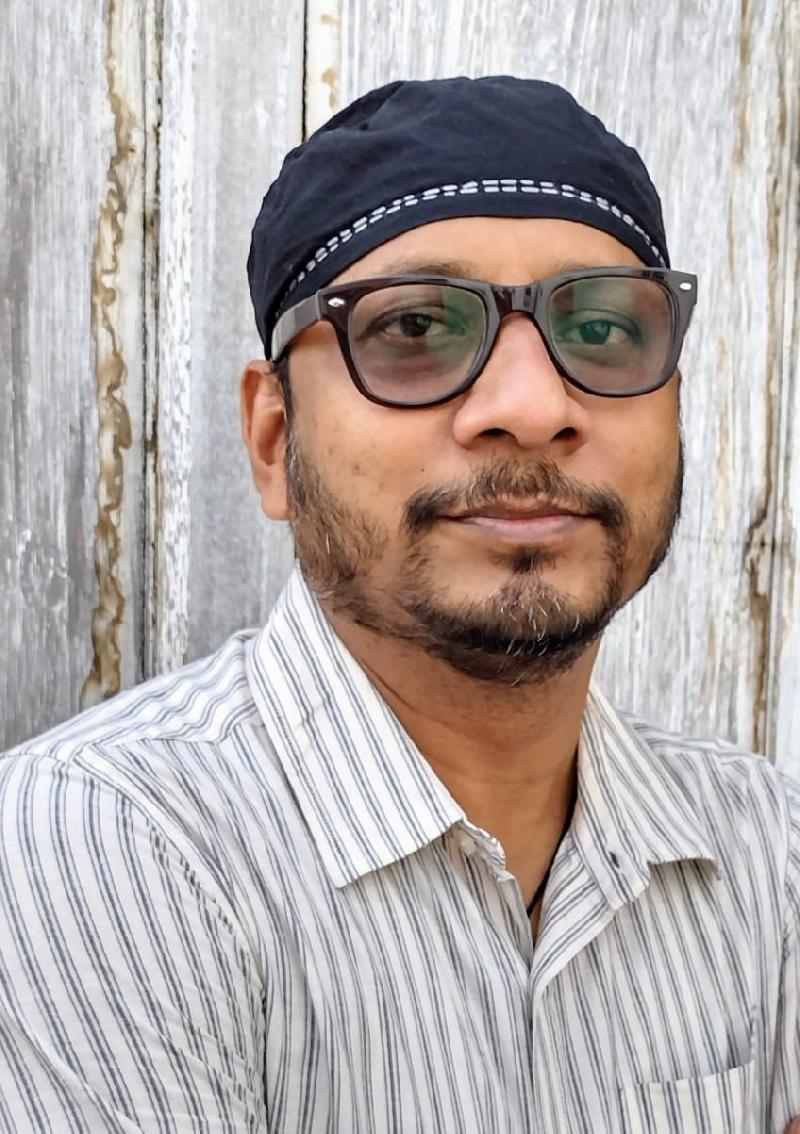R. M. Palaniappan is an eminent artist who works in mostly mixed media prints. He plays various roles such as a printmaker, a painter, a curator, a former Regional Secretary of the Lalit Kala Akademi, a closet scientist, a mathematician, and an avid reader. He is interested in aeronautics and systems of notation which signifies the specifics of time, place, and sequence. He has received several awards and honors including the Fulbright Grant.
Rabin Mondal, born Rabindra Nath Mondal in 1929 in Howrah, West Bengal, was a renowned Indian painter and a founding member of the Calcutta Painters. After graduating in commerce from Calcutta University in 1952, he pursued his artistic education at the Indian College of Art and Draughtsmanship, Calcutta, and the Asutosh Museum of Indian Art. In 1964, he co-founded the "Group of Eight," which played a pivotal role in promoting modernist art across India. Mondal's distinctive works, characterized by tragic-looking figures titled "kings" and "queens," painted in oil on canvas, gained national attention through
Rakhee Roy is a painter and artist who completed her art training at the Academy of Fine Arts Kolkata, in 2006. Her solo exhibitions have been organized in several Art galleries, narrating her journey, including a solo Exhibition “In Quest of Green” at Birla Academy of Arts and Culture, Kolkata in April 2010 following “In Quest of Green -2” at the Academy of Fine Arts, Central Gallery, Kolkata in November 2012, “In Quest of Green-3” at Nehru Art Centre, Mumbai in August 2013 and at Jehangir Art Gallery, Mumbai in September 2013, and finally “In Quest of Green” at Academy of Fine Arts, Central Gallery, Kolkata in November 2015. Her works have been exhibited in a number of group shows including in Taj Bengal, in the show of “Eye Within” in 2008, Cymroza Art gallery, Mumbai in 2006 and 2010, Gajanendra Prodershani in 2011, Annual Show at Birla Academy of Arts and Culture, Kolkata, in 2011, Annual Show at Academy of Fine Arts, Kolkata, in 2011, “Ganges Art Mela” at Ganges Art Gallery, Kolkata in March 2013 and 2014, Academy of Fine Arts, in February 2015 and North Gallery, Kolkata in January 2013, Mirage Art Gallery, Kolkata in March 2013, Bangalore Art Fair in August 2013, “SudrakUtsav” at Academy of Fine Arts, Kolkata in October 2013 and in November 2015, a group show in Indira Gandhi Centre for She participated in “India Art Festival,” India’s Contemporary Art Fair, held at National Stadium, in “Artistic Symposium London, 2016” at the Nehru Centre, London during March-April 2016, in “World Art Fair Dubai, 2017” at the World Trade Centre, Dubai during April 2017, Delhi art festival, November 2017, Jaipur art summit, December 2017, First international Kala Mela, Delhi 2018, Environment day workshop, American center Kolkata, July 2018, Open Air workshop conducted on Kolkata 25K Marathon conducted by TATA STEEL at Kolkata, January 2019, She participated in ART REVOLUTION TAIPEI (TAIWAN), 2020 and 2021.
Ramendranath Chakravorty's artistic journey began in 1919 when he enrolled at the Government School of Art in Calcutta. In 1921, he continued his education at Kala Bhavan, Santiniketan. His career at the Government School of Arts in Calcutta started in 1929 as the Head Assistant Teacher, later serving as the Officiating Principal from 1943 to 1946, during which he introduced the Graphics Department in 1943. In 1949, he became the Principal of the School. In 1937, Ramendranath pursued higher studies in painting at the Slade School of Art in London, followed by a solo exhibition in London in 1938. From then until his untimely death in 1955, he exhibited his works worldwide and played a crucial role in organizing exhibitions of Indian artists both in India and abroad.
Ramkinkar Baij was born in Bankura West Bengal in 1910. He studied at the Kala Bhavan, Vishwa Bharati University, Santiniketan in 1925. Trained by two European sculptors, one of whom was a disciple of Bourdelle, who was on a visit to Santiniketan on an invitation by Tagore, his style was still uniquely his own. Groomed by his mentors, Nandalal Bose and Tagore, the clay modeler turned artist. Working at a time when traditional art was transitioning to modern art, Baij's work proved to be crucial to Indian art history. Nature and Baij's folk background turned out to be the crucial influences in the formation of his style. Later, he headed the Department of Sculpture at the Kala Bhavan. He always believed that it is only momentum that creates tension in a work of art. His work portrays tremendous energy, joy, vital, and reaching out to light. It is earthy and dynamic while showing a surging movement or growth. His path-breaking work in sculpture has been both acknowledged and respected, first in Santiniketan, then across the country, and internationally as well. His sand and pebble sculptures are noted for a typical, lyrical, metrical sensuality, which has an amazing oneness with nature. Indian sculpture, hitherto limited to academic naturalism, was transformed by him. He mostly depicted Santhal tribal art and life in his work and enhanced them with an understanding of Western expressionism that was gleaned from books at the library of the Kala Bhavan. Although primarily known for his expressionistic sculpture, he was a gifted painter. This sense of rhythm that his sculpture is noted for is manifest brilliantly in his watercolors. The fluidity of this medium lent itself to his style.
Raja Ravi Varma was an Indian painter and artist, considered as one of the greatest painters in the history of Indian art. Raja Ravi Varma is known for his amazing paintings, which revolve mainly around the Puranas (ancient mythological stories) and the great Indian epics - Mahabharata and Ramayana. Ravi Varma is one of the few painters who managed to accomplish a beautiful union of Indian tradition with the techniques of European academic art. This is one of the reasons why he is considered as one of the most, if not the most prominent Indian painters. Varma was also responsible for taking Indian art all over the world with his impeccable technique. While the Europeans and other art lovers admired his technique, the laymen of India enjoyed his work for its simplicity. More often than not, Varma’s paintings highlighted the beauty of South Indian women which were admired by all. His portrayal of Hindu gods and goddesses went on to become worship material for many people belonging to the lower castes. Back then, these people were often forbidden from entering temples and thus they celebrated Varma's works, for they gave them an idea of how the deities looked inside the temple. He also managed to improve artistic knowledge and spread the importance of art among Indian people. He achieved this by making affordable lithographs, which were accessible even to the poor. Alternatively, this also made him a household name and Raja Ravi Varma soon captured the hearts of all. Recognizing his feat, Viceroy Lord Curzon honored him with the Kaisar-i-Hind Gold Medal for his service in the furtherance of public interest.
S. G. Vasudev received his degree in Art from Madras Arts College. He is also one of the longtime artists associated with Cholamandal Artists' Village. He stays in Bangalore. He is one of the most prominent painters in Karnataka and has held art shows in many parts of the world and his works are in collections at various galleries. He has won many awards in India and abroad. He acclaims in an interview: "As you know, there are a few distinct and recurring themes in my works. One of them is “Vriksha” or the Tree of Life. I unknowingly discovered this theme. I was initially fascinated with the tree and painted many pictures with the tree juxtaposed with other elements. Gradually the tree moved to the center of the stage and started absorbing various elements and forms; just like the gigantic banyan tree which is so amorphous and protective.
Samir Aich is a tireless experimenter and has been busy accomplishing impossible things. He has sought to 'figurate' abstract concepts such as the primordial force of Nature, or its earthly counterpart, the animal spirit. Earlier on, his work depicted these concepts in the shape of a variety of awe-inspiring imagery. Such depictions of elemental mass and energy provided the viewer an initial cue to the inner world of this indefatigable painter, he soon shifted his plane of visual expression by endeavoring to accomplish another near impossibility, namely articulating in terms of the black pigment covering virtually the whole of the canvas space. One finds an echo of what the great Turner had tried to do when he wanted to picture the night itself. The canvas is first uniformly painted and light is then introduced onto this surface by regular patches of white, green, and red ochre and then effacing it, which are then usually successively veiled by later application of dark but transparent wash. Like toned varnishes, these subsequent patches not only reduce the whites and make them recede in shadow, but their liquidity responds to the material texture of the canvas and curdles into the weave and seductive lines, restoring its physical presence. The other part of the oeuvre is in his extraordinarily sensitive modulation of tints and shades. After having reduced his color to no more than a scale of values, he pursues tonal painting with fervor and discipline valorizing the activities of his mind, evaluating, weighing, and balancing the relative strengths of all that it encounters in its search for order and the unresolved complexities. The erased areas between them have taken on a new resonance that pushes us to the figurative markers. The paintings work best when the salient elements are all held in tension on the same plane, with no element appearing to overlap or underline any other. This gives the paintings the quality of a world whose contents might be said to be suspended in a simultaneous presentness of being. The flat paint body seems less important than tone, an effacement of one layer followed by another setting a vector, shadow set against deeper shadow, Aich plots the position of objects around the nudes, marking the points where their forms reflect, intersect or overlap, the frame within the frame diverges instead of converging. Humans float through his works in gay abandon with a fluidity assuming now one form, another illuminating area as vivid streaks of lighting descending into a drizzle, a kind of lunar aesthetics grow on the viewer as our own experience abides in another pictorial space. A critical reading of Aich’s drawings, paintings however might lead one to define them as pictographically expressionistic- a faithful adherence to expressionistic- figurative markers, seemingly innocuous portrayals of still objects, and at times a mingling of both on a single canvas, is not to be viewed simplistically as work of an incurable romanticist that yields several possibilities, in turn giving rise to polemical queries that demands a sort of substantiation. A previous figurative series takes into account the complex manipulation of space in his works- large areas of a flat delineation of pigment act as a catalyst for the simplification of techniques to a form of abstraction.
A majority of Sanat Kar's works are surrealistic and have a curious dream-like appearance, mostly nightmarish. Figures are distorted and barely recognizable and leave an uncomfortable feeling behind them. The same treatment is given to objects. As a result, all his paintings hover on the edge of reality without ever actually reaching there, symbolizing the mysteries of life to which there are no answers. He was born in 1935 in Santiniketan. The artist maintains a low profile and allows his work to speak for him. His paintings are eloquent testimony to his talent and artistic powers. He uses the medium of tempera most often in his work and there are layers within layers that emerge on closer perusal. A favorite is the image of the sea: an angry grey-green out of which arise, men and women, as if just born, still with the placental fluid obscuring their faces. A large number of the creatures are amphibious, showing the all-pervading influence of water on our lives and the fear that it can generate. Sanat Kar lives in 1935 at Santiniketan. The colors Kar utilizes are in keeping with his somber mood. Mauve, dark green, browns, magentas, and greys do nothing to relieve the pervasive darkness. He plays cleverly with alternating levels of light and dark to highlight the atmosphere of gloom. The texture of the material he works with also adds to the aura and his detailed penmanship lends credence to the whole.
Sanjay Bhattacharya was born in 1958 in Kolkata. In 1982 he received his Diploma in Art from the Government College of Arts and Crafts, Kolkata. After finishing his graduation, he joined the Clarion Ad agency as an illustrator. Later he joined Hindustan Thomson Associates where he had the freedom to freelance and created a series of watercolors for his first exhibition, based on architecture and still life. He has done several exhibitions worldwide. In 1988 and 1989 he had solo exhibitions at Gallery Aurobindo in New Delhi and Chitrakoot Art Gallery, in Calcutta. In 1988 he had a solo exhibition at Dhoomimal Art Gallery, New Delhi. In 1992 he had a solo exhibition at Jehangir Art Gallery, in Mumbai. In 1994 Sanjay showcased ‘Rajiv Gandhi: Landscape of a Man’ at the National Gallery of Modern Art in Mumbai and Jehangir Art Gallery, in Mumbai. In 2002 he had a solo show ‘Painting Beyond Words’ at Arts India, New York. Sanjay is the recipient of many awards such as - He won awards from National Exhibitions, Calcutta. In 1983 and 1988 he participated in All India Watercolour Exhibitions at AIFACS and won awards. In 1988 - 1989 Sanjay received an award at the Sahitya Kala Parishad Annual Exhibition. In 1988 he won an award at the Second International Asian-European Art Biennale in Ankara, Turkey.
Sanjeet Chowdhury, a graduate of St. Xavier’s College, Kolkata in the late 1980s, is a Kolkata-based independent photographer, filmmaker, and curator committed to representing the everyday. He works with various media and formats, while 35mm manual cameras, black and white celluloid films, and wide-angle lenses remain his favorite in visualizing people and spaces. His thematic interests have a broad spectrum ranging from photography, cinema, and art history to culinary culture, religion, and popular culture that he explores through his photographic, cinematic, and curatorial practices. Sanjeet’s works have been widely exhibited in galleries, art, and film festivals as well as extensively published in books and magazines. Previously his photographs were showcased in exhibitions in London, New York, and Basel, while his video arts and films were screened at various international festivals at the Smithsonian Institute, Washington, Transmediale in Berlin, Tel Aviv, Stockholm, Shanghai, and numerous film festivals across India. More recently he curated group photography shows as well as books. Currently, he is working on two book-length projects: the first project, “Little Europe,” is a collection of his photographs from contemporary towns that were European colonies along the river Hoogly, while the second project is an anthology on the culinary history of Bengal. Besides being a practicing photo artist, Sanjeet is a collector of albumen and silver gelatin prints, glass negatives, and Daguerreotype plates. He owns a film production house, while also being one of the leading collectors of 19th and 20th century lithographs and oleographs from India. Sanjeet works out of Kolkata and Mumbai.
Sarbari Roy Chowdhury was born in 1933 in Ulpur (now Bangladesh), Sarbari Roy Chowdhury graduated from the Government College of Art and Craft, Kolata in 1956. He further studied under sculptors Prodosh Dasgupta and Sankho Chaudhuri at the M.S. University, Baroda. The artist also served as the Head of the Department of Sculpture at the Indian Art College Kolkata between 1960 and 1962. Sarbari Roy Chowdhury is known for the unique mode of expressiveness that enters his works even though the works are pictorial. His sculptures embody an eclectic synthesis of the academic realism of the East and the more innovative cubism and abstraction of the West. Deeply influenced by Hindustani classical music, Chowdhury also explored the abstractive element of music through his works. Music inspired him so much that he sought to create a visual language, a visual syntax for music through his works. A lot of influence on his style can be credited to his visit to Academia de Belle Arti, Florence in 1962 where he met Giacometti and Henry Moore in person. He won several awards including the Gagan–Abani Puraskar from Visva Bharati University, Santiniketan in 2004, and the Abanindra Puraskar from the Government of West Bengal in 2005. He passed away in 2012.
Satyajit Ray was born on May 2nd, 1921, in Calcutta and he died on April 23rd, 1992, in Calcutta. He is a renowned Bengali motion-picture director, writer, and illustrator who brought Indian cinema to world recognition with Pather Panchali (1955; The Song of the Road) and its two sequels, known as the Apu Trilogy. As a director Ray was noted for his humanism, his versatility, and his detailed control over his films and their music. He was one of the greatest filmmakers of the 20th century. Ray was an only child whose father died in 1923. His grandfather Upendra Kishore Raychowdhury was a writer and illustrator, and his father, Sukumar Ray, was a writer and illustrator of Bengali nonsense verse. Ray grew up in Calcutta and was looked after by his mother. He entered a government school, where he was taught chiefly in Bengali, and then studied at Presidency College, Calcutta’s leading college, where he was taught in English. By the time he graduated in 1940, he was fluent in both languages. In 1940 his mother persuaded him to attend art school at Santiniketan, Rabindranath Tagore’s rural university northwest of Calcutta. There Ray, whose interests had been exclusively urban and Western-oriented, was exposed to Indian and other Eastern art and gained a deeper appreciation of both Eastern and Western culture, a harmonious combination that is evident in his films. Returning to Calcutta, Ray in 1943 got a job in a British-owned advertising agency, became its art director within a few years, and also worked for a publishing house as a commercial illustrator, becoming a leading Indian typographer and book-jacket designer. Among the books, he illustrated (1944) was the novel Pather Panchali by Bibhuti Bhushan Banerjee, the cinematic possibilities of which began to intrigue him. Ray had long been an avid filmgoer, and his deepening interest in the medium inspired his first attempts to write screenplays and his cofounding (1947) of the Calcutta Film Society. In 1949 Ray was encouraged in his cinematic ambitions by the French director Jean Renoir, who was then in Bengal to shoot The River. The success of Vittorio De Sica’s The Bicycle Thief (1948), with its downbeat story and its economy of means—location shooting with nonprofessional actors—convinced Ray that he should attempt to film Pather Panchali.
Saumen Khamrui is a Kolkata-based artist. He is a very talented young artist. His style mostly portrays landscape and cubism. He graduated from the Government College of Art and Craft in the year 1997 with 1st class in Drawing and Painting and mastered the same with first class marks. Being a budding artist he has done several exhibitions and solo shows throughout the nation. He has bagged many awards like - the Abanindranth Tagore Award and, the Camlin Scholarship award, He attended various workshops like Bhavan Prangan, organized by Rajya Charukala. He played the role of an art camp trainer organized by Rajya Charukala Parishad, Deptt. of Information & Cultural Affairs, Govt. of West Bengal, Kolkata.
She was born in 1960, she has created her niche in the world of contemporary art for the last 35 years. Her creative collection is eclectic, encompassing a wide range of mediums ranging from painting, murals, experiential installation performances, and films to installations, sculptures, and each a unique expression of her style. She has brought a synergy of her unique sensibilities and her art. Working with different mediums like - oils on canvas, inks, mixed mediums, ceramics, and printmaking, her work has redefined the basic contours of figurative art in India, finding admirers across the planet. Seema's most recent thematic engagement has been that of the 'Hiranyagarbha', which evolved from Yajur Veda, reflecting the quiet and subtle beauty of constant procreation. All the works are like a prayer - a way of meditation. Though these works are spiritual they are not religious.
















